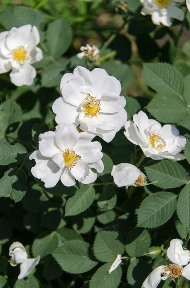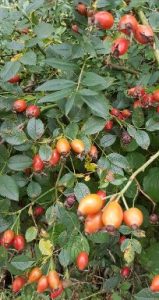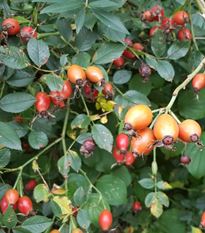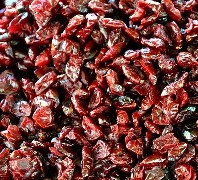 We may feel a little melancholic now as summer starts to fade and signs of autumn appear; as we catch a glimpse of the withering flowers on rose bushes when we are out walking or on our way home from the work. A little consolation, however, is provided by the beautiful bright red spots of colour of rose hips, which develop from the flowers of wild rose (also dog rose, botanical name Rosa canina L.). Rose hip is a common medicinal plant which grows in the wild – as bushes on the wayside and forest’s edge [1]. Its cosmetic effect as well as its healing power have a rich history. Greek mythology attributes the beauty of Aphrodite – the goddess of love – to this red fruit of the dog rose. Rose hip was also used in the Middle Ages as a remedy for rheumatic problems [2]. In complementary medicine, rose hip is still used for various forms of inflammatory joint problems.
We may feel a little melancholic now as summer starts to fade and signs of autumn appear; as we catch a glimpse of the withering flowers on rose bushes when we are out walking or on our way home from the work. A little consolation, however, is provided by the beautiful bright red spots of colour of rose hips, which develop from the flowers of wild rose (also dog rose, botanical name Rosa canina L.). Rose hip is a common medicinal plant which grows in the wild – as bushes on the wayside and forest’s edge [1]. Its cosmetic effect as well as its healing power have a rich history. Greek mythology attributes the beauty of Aphrodite – the goddess of love – to this red fruit of the dog rose. Rose hip was also used in the Middle Ages as a remedy for rheumatic problems [2]. In complementary medicine, rose hip is still used for various forms of inflammatory joint problems.
Health and nutrition
 In the cosmetics industry as well as in the areas of healthy nutrition and medicine, rose hip is gaining increasing importance as it is attributed with numerous health-promoting properties [3, 4]. A number of research groups have meanwhile confirmed the positive effects of rose hip for joint pain and stiffness in the morning [5, 6]. As these problems are also side effects of oestrogen inhibitor therapy, rose hip could possibly become important in adjuvant therapy for cancer. Patients affected who use rose hip within the scope of complementary medicine advice at Munich Tumour Centre, repeatedly report positive experiences in this regard. For precise use in treatment, however, further studies are required especially for cancer patients.
In the cosmetics industry as well as in the areas of healthy nutrition and medicine, rose hip is gaining increasing importance as it is attributed with numerous health-promoting properties [3, 4]. A number of research groups have meanwhile confirmed the positive effects of rose hip for joint pain and stiffness in the morning [5, 6]. As these problems are also side effects of oestrogen inhibitor therapy, rose hip could possibly become important in adjuvant therapy for cancer. Patients affected who use rose hip within the scope of complementary medicine advice at Munich Tumour Centre, repeatedly report positive experiences in this regard. For precise use in treatment, however, further studies are required especially for cancer patients.
 The bioactive constituents of rose hip especially include vitamin C (ascorbic acid), carotenoids and polyphenols. All of these constituents can have an antioxidant effect. This means they are able to deactivate free radicals and nitrosamines, and consequently protect the body against oxidative stress and possibly even against cancer [7]. The ascorbic acid content of this small red fruit is so high that the daily requirement of vitamin C – 100 mg – is contained in just 9 g of rose hip. By way of comparison: to obtain the same amount of vitamin C you would need to eat 800 g of apples, 450 g sauerkraut or 160 g lemons [8]. During cancer therapy it is important to note that the effect of some cytostatics can be reduced through excessive doses of vitamin C [9] . Cancer patients should therefore only use rose hip in consultation with their doctor.
The bioactive constituents of rose hip especially include vitamin C (ascorbic acid), carotenoids and polyphenols. All of these constituents can have an antioxidant effect. This means they are able to deactivate free radicals and nitrosamines, and consequently protect the body against oxidative stress and possibly even against cancer [7]. The ascorbic acid content of this small red fruit is so high that the daily requirement of vitamin C – 100 mg – is contained in just 9 g of rose hip. By way of comparison: to obtain the same amount of vitamin C you would need to eat 800 g of apples, 450 g sauerkraut or 160 g lemons [8]. During cancer therapy it is important to note that the effect of some cytostatics can be reduced through excessive doses of vitamin C [9] . Cancer patients should therefore only use rose hip in consultation with their doctor.
In the kitchen
 Rose hips are typically consumed in the form of purées, jams, tea and fruit juice [3]. It is best to pick the fruits yourself; they are easy to spot when out and about – in the garden and in hedgerows -between the months of September and November. The fruits should be a lush red colour and still be firm as this is when the vitamin C content is highest.
Rose hips are typically consumed in the form of purées, jams, tea and fruit juice [3]. It is best to pick the fruits yourself; they are easy to spot when out and about – in the garden and in hedgerows -between the months of September and November. The fruits should be a lush red colour and still be firm as this is when the vitamin C content is highest.
When preparing the rose hips keep in mind that vitamin C can be degraded at excessive temperatures. Long storage periods also have a negative impact on the vitamin C content [10]. As rose hip’s vitamin C content is extremely high and the median loss of value during preparation amounts to 30% [9], the final product still provides a considerable amount of vitamin C. Unlike ascorbic acid, the carotenoid lycopene contained in rose hip – in a similar way to tomatoes – is converted into a more effective biological form when cooked [10]. There is consequently still a positive effect on health even after the fruit has been cooked, for example made into rose hip jam.
 The oldest means of conserving food is to dry it. In the case of rose hips, simply leave them to dry in the sun, over the fire or spread out on a baking tray in the oven. Due to the thermal instability of vitamin C mentioned above, the temperatures should not be too high. The dried fruit can then be used to prepare rose hip tea or as an ingredient for muesli.
The oldest means of conserving food is to dry it. In the case of rose hips, simply leave them to dry in the sun, over the fire or spread out on a baking tray in the oven. Due to the thermal instability of vitamin C mentioned above, the temperatures should not be too high. The dried fruit can then be used to prepare rose hip tea or as an ingredient for muesli.
Enjoy the glorious blaze of autumnal colour rose hips provide when out on your next stroll. Keep an eye out for these signs of the rose’s second life stage – the nutritious, little red fruits which really pack a punch!
BIBLIOGRAPHY
[1] J. Bielenberg: Arthrose – Hagebutte auf dem Prüfstand, Pharmazeutische Zeitung, 2007 (6).
[2] C. Chrubasik et al.: A One-year Survey on the Use of a Powder from Rosa canina lito in Acute Exacerbations of chronic pain., Phytother. Res., 2008 22(9), p. 1141–1148.
[3] O.Sagdic et al.: Bioactive and rheological properties of rose hip marmalade, J Food Sci Technol, 2015 52(10), p. 6465–6474.
[4] I. Marmol et al.: Therapeutic Applications of Rose Hips from Different Rosa Species, Int J Mol Sci., 2017 18(6), p. 1137.
[5] E. Rein et al.: A herbal remedy, Hyben Vital (stand. powder of a subspecies of Rosa canina fruits), reduces pain and improves general wellbeing in patients with osteoarthritis–a double-blind, placebo-controlled, randomised trial, Phytomedicine., 2004 Jul 11(5), pp. 383-91.
[6] S. Willich et al.: Rose hip herbal remedy in patients with rheumatoid arthritis – a randomised controlled trial, Phytomedicine, 2010 17(2), pp. 87-93.
[7] X. Gao et al.: Evaluation of antioxidant activities of rosehip ethanol extracts in different test systems, J Sci Food Agric, 2000 (80), p. 2021-2027.
[8] H.-K. Biesalski, P. Grimm und S. Nowitzki-Grimm: Taschenatlas der Enrährung, Thieme Verlag, 2015, 6. Aufl.
[9] H. Bertz und G. Zürcher: Ernährung in der Onkologie – Grundlagen und klinische Praxis, Schattauer Verlag, 2014, 1. Aufl.
[10] S. Knasmüller: Krebs und Ernährung, Risiken und Prävention – wissenschaftliche Grundlagen und Ernährungsempfehlungen, Thieme Verlag, 2014, 1. Aufl.